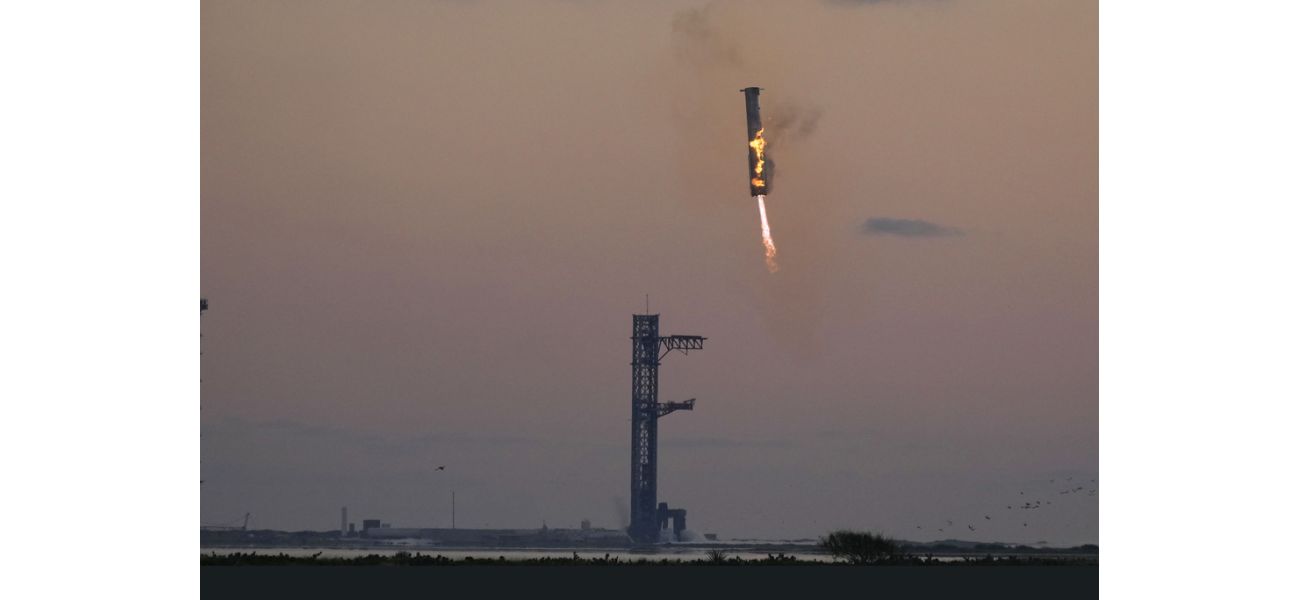SpaceX successfully completes most daring launch yet in the genre of science fiction.
SpaceX successfully completes impressive test flight of massive Starship rocket, retrieving booster with robotic arms.
October 13th 2024.

SpaceX has successfully completed its most daring test flight yet, showcasing the immense capabilities of its massive Starship rocket. In an unprecedented move, the returning booster was caught by mechanical arms back at the launch pad.
The launch took place at sunrise on Sunday from the southern tip of Texas near the Mexican border. The towering Starship, standing at almost 121 meters, gracefully soared over the Gulf of Mexico, following the same path as its four predecessors that unfortunately met their demise either shortly after liftoff or during their descent into the sea.
However, this time, SpaceX's founder and CEO Elon Musk decided to up the ante and take on more risk. The company successfully brought back the first-stage booster to land at the same pad it had taken off from just seven minutes prior. This feat was made possible by the launch tower's impressive metal arms, playfully nicknamed "chopsticks", which caught the descending 71-meter booster.
Musk could not contain his excitement as he announced, "The tower has caught the rocket!! Science fiction without the fiction part." The entire company erupted in cheers and celebrations, with employees jumping and fist-pumping in the air as they witnessed the historic moment of the booster being gently lowered into the arms of the launch tower.
Spacex's Dan Huot, who was present at the launch site, couldn't contain his emotions, saying, "Even in this day and age, what we just saw is magic. I am shaking right now." His colleague Kate Tice, who was at SpaceX headquarters in Hawthorne, California, added, "Folks, this is a day for the engineering history books."
An hour later, the spacecraft atop the booster made a controlled landing in the Indian Ocean, adding to the day's success. It was a nail-biting decision for the flight director, who had to manually control the landing in real-time and decide whether to attempt it or not. SpaceX had set strict criteria for the booster and launch tower to be in good and stable condition, or else it would have ended up in the gulf like its predecessors. Thankfully, everything was deemed ready for the catch.
After the booster was safely secured, the spacecraft continued on its journey around the world. Cameras in the Indian Ocean captured the booster's fiery descent as it precisely impacted the designated spot. However, it was not meant to be recovered for this demonstration. "What a day," exclaimed Huot. "Let's get ready for the next one."
This successful test flight comes after SpaceX's last launch in June, which was its most successful yet, completing the entire flight without exploding. However, even that mission had its shortcomings, with some pieces coming off towards the end. In an effort to constantly improve, SpaceX upgraded the software and reworked the heat shield, resulting in a smoother and more successful flight this time around.
For the past nine years, SpaceX has been recovering the first-stage boosters of its smaller Falcon Nine rockets after delivering satellites and crews to orbit. However, these boosters land on floating ocean platforms or on concrete slabs several miles away from the launch pads. In contrast, the Starship booster was successfully landed back at its launch pad, marking a significant advancement in reusable technology.
This breakthrough in recycling boosters has not only increased the launch rate for SpaceX but also saved them millions of dollars. With the Starship, Musk intends to do the same, as it is the biggest and most powerful rocket ever built with 33 methane-fuel engines on the booster alone. NASA has already placed an order for two Starships to land astronauts on the moon later this decade, and SpaceX has even bigger plans to use it for future missions to Mars.
Stay updated with all the latest breaking news, celebrity gossip, and sports updates by following our WhatsApp channel. No comments, no algorithm, and your privacy is safe with us.
The launch took place at sunrise on Sunday from the southern tip of Texas near the Mexican border. The towering Starship, standing at almost 121 meters, gracefully soared over the Gulf of Mexico, following the same path as its four predecessors that unfortunately met their demise either shortly after liftoff or during their descent into the sea.
However, this time, SpaceX's founder and CEO Elon Musk decided to up the ante and take on more risk. The company successfully brought back the first-stage booster to land at the same pad it had taken off from just seven minutes prior. This feat was made possible by the launch tower's impressive metal arms, playfully nicknamed "chopsticks", which caught the descending 71-meter booster.
Musk could not contain his excitement as he announced, "The tower has caught the rocket!! Science fiction without the fiction part." The entire company erupted in cheers and celebrations, with employees jumping and fist-pumping in the air as they witnessed the historic moment of the booster being gently lowered into the arms of the launch tower.
Spacex's Dan Huot, who was present at the launch site, couldn't contain his emotions, saying, "Even in this day and age, what we just saw is magic. I am shaking right now." His colleague Kate Tice, who was at SpaceX headquarters in Hawthorne, California, added, "Folks, this is a day for the engineering history books."
An hour later, the spacecraft atop the booster made a controlled landing in the Indian Ocean, adding to the day's success. It was a nail-biting decision for the flight director, who had to manually control the landing in real-time and decide whether to attempt it or not. SpaceX had set strict criteria for the booster and launch tower to be in good and stable condition, or else it would have ended up in the gulf like its predecessors. Thankfully, everything was deemed ready for the catch.
After the booster was safely secured, the spacecraft continued on its journey around the world. Cameras in the Indian Ocean captured the booster's fiery descent as it precisely impacted the designated spot. However, it was not meant to be recovered for this demonstration. "What a day," exclaimed Huot. "Let's get ready for the next one."
This successful test flight comes after SpaceX's last launch in June, which was its most successful yet, completing the entire flight without exploding. However, even that mission had its shortcomings, with some pieces coming off towards the end. In an effort to constantly improve, SpaceX upgraded the software and reworked the heat shield, resulting in a smoother and more successful flight this time around.
For the past nine years, SpaceX has been recovering the first-stage boosters of its smaller Falcon Nine rockets after delivering satellites and crews to orbit. However, these boosters land on floating ocean platforms or on concrete slabs several miles away from the launch pads. In contrast, the Starship booster was successfully landed back at its launch pad, marking a significant advancement in reusable technology.
This breakthrough in recycling boosters has not only increased the launch rate for SpaceX but also saved them millions of dollars. With the Starship, Musk intends to do the same, as it is the biggest and most powerful rocket ever built with 33 methane-fuel engines on the booster alone. NASA has already placed an order for two Starships to land astronauts on the moon later this decade, and SpaceX has even bigger plans to use it for future missions to Mars.
Stay updated with all the latest breaking news, celebrity gossip, and sports updates by following our WhatsApp channel. No comments, no algorithm, and your privacy is safe with us.
[This article has been trending online recently and has been generated with AI. Your feed is customized.]
[Generative AI is experimental.]
0
0
Submit Comment





